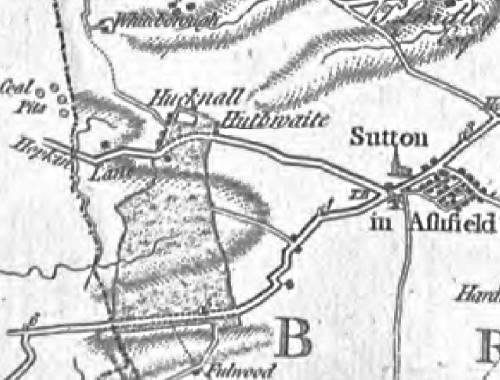A Hucknall History
Foul and Dirty Hucknall
Continuing previous explanation how Huthwaite become more broadly known as Hucknall inside Sherwood Forest, can understand naming their Colliery Company New Hucknall. It described sinking new shafts beneath known Hucknall grounds after dismissing ideas reopening Mellors former Pit Row works. They left that Blackwell Road mine, thereafter known as the Old Hucknall Colliery.
Inviting mass arrival of mining families into a modern Colliery understands they faced taunts about their Hucknall Huthwaite homes having been sited in a previously well known Dirty Hucknall. Thus, they very proudly accepted historian theories reasoning a far older coal mining heritage used to leave filthy roadways in bad disrepair. Although assured it was never called Dirty Huthwaite, modern descriptive use of foul and dirty had readily implied either unclean, filthy, or even sexually disgusting concerns. A much broader definition is however recognisable way before narrower 19th century definitions reflect national aim to generally improve healthier living standards. Lets now sweep away all those long told, much outdated and totally misguided myths.
Fulwood
Broader extent of Hucknall grounds had knowingly spanned at least a southern Ffulwood. Literal interpretations for a foul wood can find likewise known areas elsewhere, so discovering this 13th century reference does not imply it simply described land contents. A coppice was notably recorded. There might even be some larger trees left holding nests, familiarly seen from both Crowtrees and Rookery farms. Steeply undulating pastures pooled some lower marshy areas, but dated mention behind a seemingly demeaning name actually finds beneficial result. It reasons why the crown granted individual separation from severely restricting forest laws.
Describing areas either foul or dirty, would've shared their general meaning of worthless, unprofitable or insignificant waste only in relation to the crowns vast land coverage claimed under Norman forest law. Appeals were heard and heavily penalised restrictions gradually lifted under significant forest law amendments. Here edging borders inside Sherwood Forest, one Fulwood householder had thus managed to prove part of Hucknall Huthwaite grounds were no loss to the crown. Enabling much greater freedom of use permitted any Sutton tied parishioners commoners right to raise and freely pasture livestock on the identifiable Fulwood Common.
Referring back to 14th century examples showed how some tried taking advantage of Fulwood Common privileges. Appointed role of a Hucknall Huthwaite resident Woodward oversaw those land interests, wielding legal powers thwarting any illegal activities. But this logical explanation how a Fulwood hamlet achieved early independence can fully dismiss past ideas once siting a monastery. Likeliest causing confusion are historic references to a second Fulwood in Nottingham held by the aforementioned William Peverel. Being known founder of Lenton Priory out of love of divine worship and for the good of the souls of his lord King William, of his wife Queen Matlida, of their son King William and of all their and his ancestors
. His manor interest there neatly wraps up that idea.
Dirty Hucknall

Nottinghamshire map credited c1791 Benjamin Baker may well indicate relative insignificance by omitting the Hucknall Huthwaite hamlet location. Nonetheless, it still clearly outlined where a large proportion of its area had become known as Dirty Hucknall.
Fuller extent of these designated Fulwood Common grounds spanning Hucknall forest lands is far better detailed from Chapmans 1774 Nottinghamshire coverage. 
Classifying entire marked area as foul wood did manage to assert a Fulwood address, by establishing a farm upon extreme gentler sloping south edge.
Rising numbers of Hucknall Huthwaite farmers might benefit making free use of their commons. But as it claimed a significant proportion of land, that still restricted growth of an emerging rural hamlet. They'd at least gain individual county recognition when also sharing Sherwood borders, which introduced their equally descriptive naming next referring to Dirty Hucknall.
Removing former Derbyshire forest inclusion from Nottinghamshire's main interests next follows county borders when 1500 Sherwood perambulations begin determining edge is along both dyrtie hucknall adjacent ffulwood.
Dirty Hucknall might have given more specific separate title for largest part those commons fields. Nevertheless, because some farmers were royal tenants, those same higher powers first influencing renaming of Huthwaite into Hucknall, provides further evidence supporting how Dirty Hucknall became more than another alternative address before Hucknall-under-Huthwaite best suited industrial expansion.
Royal interests keeping Sherwood Forest basically dwindled after English Civil Wars led to executing Charles I. Gifting or selling off much of this crowns land created private 18th century noble estates collectively known as The Dukeries. If that didn't make Dirty Hucknall addressing redundant, then entire Sutton-in-Ashfield deforestation certainly did. Chapmans map captured layout before c1800 allotment of all that Fulwood and Dirty Hucknall common land introduces separate developments laying Common Road.
Hucknall-under-Huthwaite
An alternative and perhaps more accurate fuller description already recognised a rural Hucknall-under-Huthwaite. Nonetheless, there'd been no shame at all for those homed on understandable Dirty Hucknall forest land. Officials and relocated residents could therefore extend recorded use relating previous known address. However, my great grandmother Elliott forewarned their arrival welcomed beliefs blaming past cause on an Old Hucknall Colliery. Huthwaite schooling taught same historian explanations, which had easily managed to proudly long satisfy this modern mining community while willingly adapting theories to combat any further discovered conflicting evidence. All strongest popular beliefs are built upon some claimed factual basis in order to dismiss logical alternative notions. Although it always seemed easy enough formulating a much simpler misinterpreted archaic basis, its just taken many years of broader research before confidently fully justifying this totally unique and hopefully now irrefutable explanation.
07 May 03 by Gary Elliott Updated 06 Jun 21
